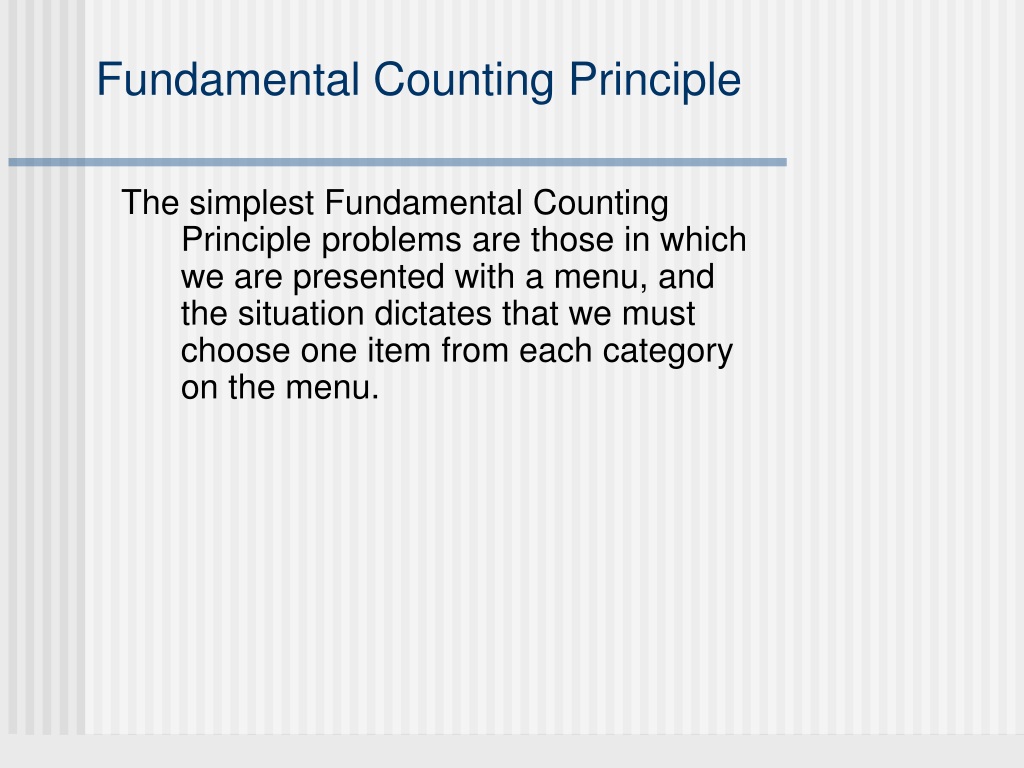
- #Fundamental counting principle how to#
- #Fundamental counting principle movie#
- #Fundamental counting principle license#
Maybe we could calculate all possible pancake servings? Thick or thin. The Basic Counting Principle When there are m ways to do one thing, and n ways to do another, then there are m×n ways of doing both. That's all, folks! The fundamental counting principle calculator really is that simple, so make sure to play around with it and see how many options the world around you offers. If you add new ones, the formula, and result will change accordingly. It involves drawing a 'slot' for each possible outcome, filling in the number of possibilities for each outcome, and then multiplying across. The FCP uses the operation of multiplication. In total, the fundamental counting principle calculator allows up to ten characteristics for the choice you're making! However, observe that the tool will already begin its calculations when you input two numbers. The Fundamental Counting Principle is used when order is implied or stated, and repetition may or may not be allowed. However, every variant of the first characteristic must have the same number of options for the second (for instance, every car company must have the same number of colors available).Īlthough you first see only two variable fields, more will appear once you begin inputting data.
#Fundamental counting principle how to#
Check out the dice roller calculator to learn how to estimate the dice roll probability. The things in question can be pizza toppings, the color of a car, the score on dice when you roll it, or anything else of that sort. When you look at the fundamental counting principle calculator, you'll see two variable fields for the number of choices for the first and second things. Lastly, before we let you go for today, let's see how to use Omni's fundamental counting principle calculator to solve all such problems in the blink of an eye!

Tree diagrams can be used to find the number of possible outcomes and calculate the probability of possible outcomes. Each branch in a tree diagram represents a possible outcome. We can apply to them the same counting rules as in the fundamental counting principle above, as long as for each variant of the first thing, we have the same number of options for the second thing, and so on. Count outcomes using tree diagram CCSS.Math: 7.SP.C.8, 7.SP.C.8b Google Classroom About Transcript Tree diagrams display all the possible outcomes of an event.
#Fundamental counting principle movie#
Observe how we can apply the same reasoning to many other life-like problems, e.g., buying a car (the company, the model, the color), choosing a movie for the evening (the platform, the genre), etc. The Fundamental Principle of Counting, or the Product Rule When a die is rolled and penny flipped, there are 6 × 2 12 possible outcomes. Therefore, if we apply the multiplication principle to our problem, we'll see that we have:

Note how it's important each place had the same number of sizes, pizzas, and sauces on offer. In principle, we're choosing:Īccording to the data above, we have 4 choices for the pizza place, 3 possible sizes, 12 different sets of toppings, and 4 sauces to choose from. Let's use the counting rules, i.e., the fundamental counting principle to see how many combinations we have here. The fundamental counting principle states that if one event can occur in A different ways and a second event can occur in B different ways, then the total.

Coincidentally, each restaurant has 12 different pizzas to choose from and 4 side sauces.
#Fundamental counting principle license#
Find the probability that a license plate does not contain a 3. 0.038 8 Example Using the Fundamental Counting Principle C. Find the probability that a license plate has the letter Q. There are then 2圆12 ways that you can flip a coin androll a die. you can flip a coin and 6 ways that you can roll a die. Examples using the counting principle: Let's say that you want to flip a coin and roll a die. Suppose that there are 4 pizza places around you, and each offers its products in 3 different sizes. Example Using the Fundamental Counting Principal B. The Fundamental Counting Principle is the guiding rule for finding the number of ways to accomplish two tasks. You feel picky, so you decide to browse through all the options you have on offer. If there are multiple groups of things that you could make a decision on, then use the Fundamental Counting Principle, but if you just have one large group. Successive numbers must be different, but the first and third can be the same.Suppose that you'd like to order pizza.

Each combination consists of three numbers in succession. \(\quad\) e) \(\quad\) \(A, B\) and \(C\) must be the middle letters in any order with no repetitionįor Part (e) please list all possibilities.ġ0) (\quad\) A combination lock is numbered from 0 to 30. \(\quad\) d) \(\quad\) B must be the middle letter \(\quad\) c) Each letter string must begin with \(C\) \(\quad\) b) Repetition of the letter \(A\) is not allowed \(\quad\) a) \(\quad\) No conditions are imposed How many of these letter strings are possible if:


 0 kommentar(er)
0 kommentar(er)
